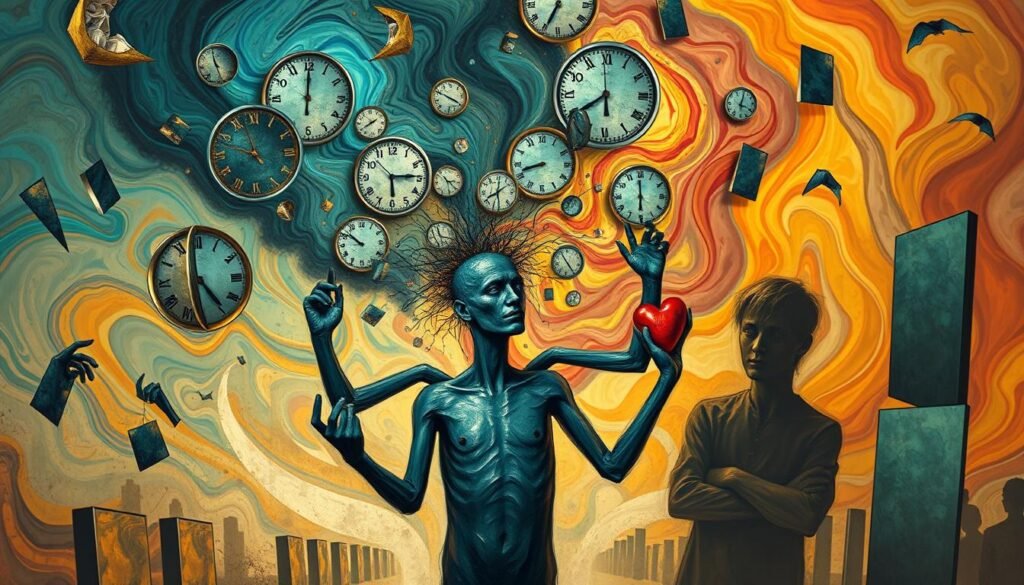Bipolar disorder is found in about 2.8% of U.S. adults. It’s more than just mood swings. It includes severe conditions like manic anxiety, which affects daily life greatly. Understanding manic anxiety is key, especially since it’s related to bipolar disorder. People with this condition experience high energy and mood peaks. But, these are followed by extreme lows. This article talks about what causes manic anxiety, its symptoms, and how to manage it. We provide insights for those affected and their support circles. Through this article, we aim to increase awareness and share coping methods. This way, we’re all working together towards better mental health.
Key Takeaways
- Manic anxiety can significantly affect individuals diagnosed with bipolar disorder.
- Understanding the triggers of manic episodes is vital for effective management.
- Coping strategies play a crucial role in minimizing the impact of manic anxiety.
- Bipolar disorder begins often during the teenage years or early twenties.
- Pressure from relationships and responsibilities can exacerbate mood swings.
- Seeking professional help is essential for proper diagnosis and treatment.
What is Manic Anxiety?
Manic anxiety is a heightened form of anxiety during manic episodes. It greatly affects personal well-being. The definition of manic anxiety includes symptoms like high energy, fast thoughts, and impulsive actions. These can lead to overwhelming emotional highs, making daily tasks hard.
People with manic anxiety might feel irritable and restless. These feelings disrupt life and hurt mental health and relationships. It’s hard for them to stay calm during these times. This condition shows the emotional struggle of those with bipolar disorder, where mood swings are frequent.
Understanding manic anxiety helps us support and empathize with those who suffer from it. It reminds us of mental health’s complexity. It shows how crucial treatment and understanding are in handling such conditions.
Understanding Mania and Hypomania
Mania and hypomania are two different states that make you feel very up. They happen in people with bipolar disorder. Mania gives you a lot of energy and can last for more than a week. Sometimes, people with mania need to go to the hospital because it’s hard for them to do everyday things.
Mania can make you feel restless, need less sleep, and feel really good about yourself. You might talk a lot, have too many thoughts at once, and not be careful about what you do.
Hypomania is like mania but not as intense. It’s part of bipolar II disorder. It doesn’t last as long and you usually don’t need to go to the hospital. Even though it’s milder, you still feel more energetic and might not sleep much.
This milder state can make you feel really creative and super happy. Because of this, some people don’t want to ask for help. They don’t want to lose the good feelings.
Understanding mania and hypomania is key because they are big signs of mood issues. It’s important to know what they look like to get help early. Things like not getting enough sleep, using drugs, or family history can trigger these states.

Signs and Symptoms of Manic Anxiety
It’s important to know the signs of manic anxiety for managing it well. It usually comes with mania symptoms, bringing unique challenges. Look for these signs:
- Elevated mood – Individuals may feel very energetic, leading to too much excitement.
- Increased energy – You might notice a big rise in energy levels, causing restlessness or agitation.
- irritability – People become easily stressed, leading to quick frustration.
- Rapid speech – People talk fast, often switching topics quickly.
- Racing thoughts – Thoughts seem all over the place, making it hard to concentrate on one thing.
- Poor decision-making – Acting impulsively can lead to careless actions, like overspending or risky behavior.
Manic anxiety does more than just affect the individual; it can hurt relationships, work, and daily life. Recognizing these signs early can help in finding the right treatment and support. This can make life better.

Symptoms of mania bring big challenges, and they mix with anxiety, making things more complex. Knowing about this is the first step to managing it and getting the right support.
| Sign/Symptom | Description |
|---|---|
| Elevated Mood | Unusually high energy and enthusiasm, sometimes borderline euphoria. |
| Increased Energy | A surge in motivation leading to restlessness or an inability to stay still. |
| Irritability | Heightened frustration with minimal provocation. |
| Rapid Speech | Talking quickly, often shifting topics rapidly, making communication challenging. |
| Racing Thoughts | Inability to slow down mental processes, resulting in difficulty concentrating. |
| Poor Decision-Making | Engaging in impulsive actions without considering potential consequences. |
Causes of Manic Anxiety
The causes of manic anxiety are complex. They often involve genetics, biology, and the environment around us. If a family member has bipolar disorder, you might be more likely to have manic anxiety. This shows there could be a genetic factor at play.
Things that happen in our lives can also trigger mania. Traumatic events or big life changes can start manic episodes. Not sleeping enough can do it, too. And using drugs or alcohol when feeling down can make anxiety worse.
How our brains work is another key piece. The levels of certain chemicals in our brain can affect our moods. Below is a table. It shows statistics for people with Bipolar I disorder, including how common anxiety is among them:
| Statistic | Percentage |
|---|---|
| Patients with anxiety at baseline | 61.4% |
| Patients with irritability at baseline | 62.4% |
| Patients with agitation at baseline | 76.4% |
| Patients with severe AIA (anxiety, irritability, agitation) | 34.0% |
| Patients with three or more depressive symptoms | 47.3% |
| Patients with a MADRS total score of ≥20 | 13.5% |
People with mixed episodes of mania and depression struggle more. They have manic behaviors more often and for longer periods. Knowing about these triggers for mania helps us understand the link between mania and anxiety in bipolar disorder.

Triggers of Manic Episodes
Knowing what starts your manic episodes is key in handling bipolar disorder. People have different triggers, which makes paying attention to how you react to things important. Common triggers are things in your environment, big life changes, and not getting enough sleep. By knowing what affects you, you can either lessen the episodes or stop them before they start.
Keeping a mood diary helps you track what sets off your episodes. By writing down your feelings and important life events, you can understand yourself better. Input from those close to you can make this even more helpful. Big stressors, like losing your job or someone passing away, can make your anxiety worse and lead to mania. Also, about 25% of people with bipolar disorder find their mood changes with the seasons.
Studies show knowing your triggers really matters. For some, going back to a routine after a break can spark a mood spike. Weather and life’s natural hormonal changes can also bring on episodes. By being alert to these triggers, you can see patterns and get ready for anything that might upset you.
Making good lifestyle choices can also ease symptoms. Eating well, staying active, and getting enough sleep can make your surroundings more stable. This helps lessen the impact of what triggers you. To learn more about how lifestyle affects anxiety, check out these tips and strategies.
Understanding both your external and personal triggers can really empower someone with bipolar disorder. This knowledge lets you manage your condition actively, leading to a more balanced emotional life.
How Manic Anxiety Relates to Bipolar Disorder
Manic anxiety and bipolar disorder intertwine, affecting mood swings deeply. Studies show anxiety is more common in those with bipolar disorder. The risk is three to seven times more than others. Over half of people with bipolar disorder also have an anxiety disorder at some time.
It’s key to know the types of bipolar disorder. Bipolar I involves manic episodes. Bipolar II has hypomanic episodes and depression. Manic anxiety can make these worse and harder to treat. Conditions like cyclothymia show how manic anxiety can appear in different ways within bipolar disorder.
Those dealing with both manic anxiety and bipolar disorder face more challenges, like substance abuse. Good self-care is crucial. This includes being social, exercising, sleeping well, and relaxing. Treating both conditions often means using both meds and therapies, like CBT.
Knowing these connections helps in spotting early signs of anxiety. This can signal the start of bipolar disorder. Early help and knowledge-sharing among doctors can improve how well treatments work. For more info, check out this resource or this platform.
| Group | Average Onset Age | Suicidal Ideation Score | Inflammatory Markers Elevated |
|---|---|---|---|
| Anxiety Group | Late 20s | Low | Normal |
| Atypical Bipolar Disorder Group | Mid 20s | Moderate | Elevated TSH, IL-6, TNF-α, CRP |
| Bipolar Disorder Group | Early 20s | High | Significantly Elevated |
Coping Strategies for Managing Manic Anxiety
Managing manic anxiety means using different coping methods. Having a daily routine helps create stability. It’s important to sleep well and eat balanced meals to help regulate moods. Avoiding things like caffeine and nicotine keeps things steady. Practices like meditation and focusing on your breath bring mindfulness and awareness.
Self-care tips are key to understanding yourself and managing your mood and anxiety. Finding activities that make you happy, such as hobbies or working out, is good. It’s also essential to connect with people to feel supported. Having friends or joining online groups can make a big difference.
Being ready is also important. Having a plan for wellness can point out what stresses you, who to call, and what medicine to take. Thinking through what to do in a crisis, like a “fire drill,” helps recognize support and improve how you handle stress.
Getting help from a professional helps create coping methods that fit you. This step forward makes managing manic anxiety easier. It helps lower the chances of extreme mood changes and anxiety.
Treatment Options for Manic Anxiety
Treating manic anxiety takes a well-rounded approach. It’s about balancing mood symptoms with anxiety. Mood stabilizers and antipsychotics are crucial for mood stability. Medicines like valproate and lamotrigine help ease anxiety symptoms. This is true for people dealing with mixed states.
Quetiapine and olanzapine were successful in trials, reducing anxiety well. They had effect sizes of 0.35 and 0.56, showing they are effective.
Supportive psychotherapy is beneficial for those with manic anxiety. It offers emotional support and teaches coping skills. Cognitive behavioral therapy and family-focused therapy aid in spotting early mood and anxiety signs. They improve family communication, boosting support for the patient.
It’s vital to manage bipolar disorder and anxiety over the long term. Treatments may mix medication, therapy, and possibly intensive care. Working with healthcare providers helps tailor the treatment. This means adjusting medications through trial and error. It ensures side effects are minimal while treating bipolar disorder and anxiety.
| Medication Class | Examples | Effectiveness for Anxiety |
|---|---|---|
| Mood Stabilizers | Valproate, Lamotrigine | Showed improvements in controlled trials |
| Atypical Antipsychotics | Quetiapine, Olanzapine | Significant reduction in anxiety symptoms |
| Antidepressants | N/A | Caution due to risk of manic switch |
| Supportive Psychotherapy | Cognitive Behavioral Therapy | Effective in managing symptoms |
A combination of medications, therapy, and ongoing doctor-patient communication is key to treating manic anxiety. Research continues to find better approaches. For more details on treatment, check out this informative source.
Conclusion
Understanding manic anxiety is crucial because of its deep impact on someone’s life. Knowing the signs helps people manage their feelings better. It also means getting the right help when anxiety levels go up.
Using personal coping methods and professional advice improves life for those with manic anxiety. Support from mental health experts is key. Friends and family also play a big role in helping.
Making mental health a priority is vital. With the right education, community help, and treatments, people can overcome manic anxiety. They can find ways to grow stronger emotionally.